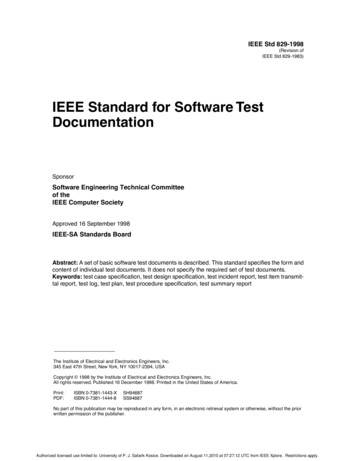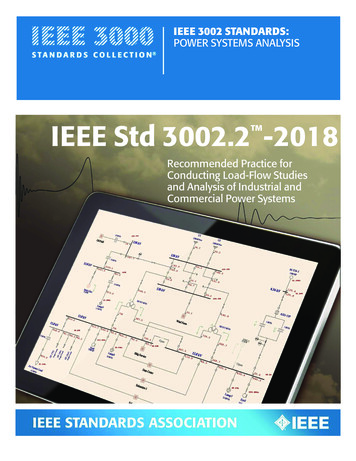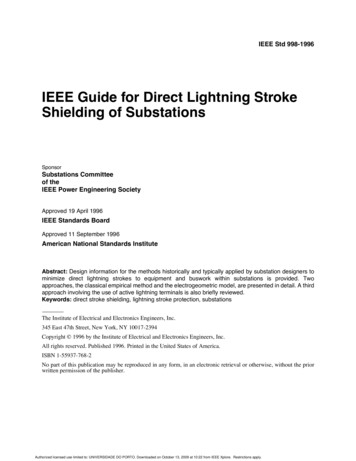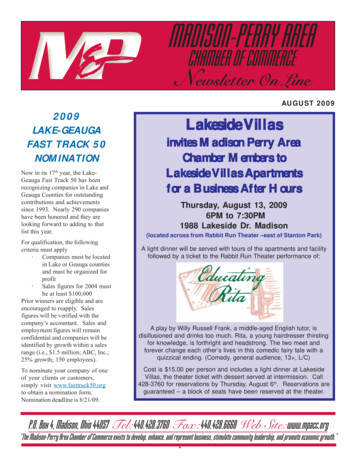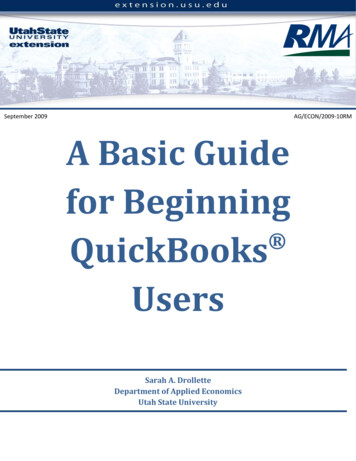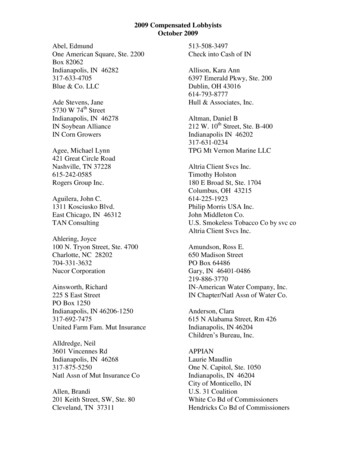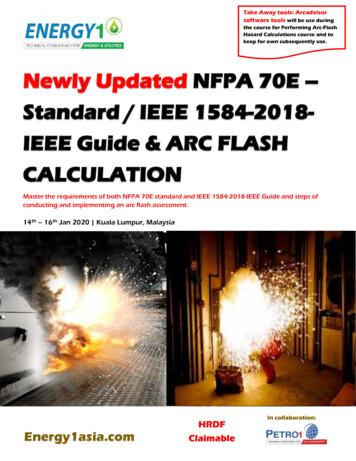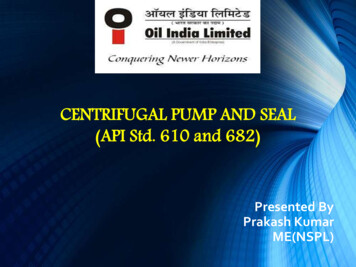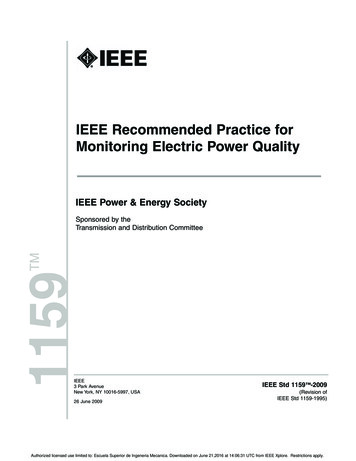
Transcription
IEEE Recommended Practice forMonitoring Electric Power QualityIEEE Power & Energy Society1159TMSponsored by theTransmission and Distribution CommitteeIEEE3 Park AvenueNew York, NY 10016-5997, USA26 June 2009IEEE Std 1159 -2009(Revision ofIEEE Std 1159-1995)Authorized licensed use limited to: Escuela Superior de Ingeneria Mecanica. Downloaded on June 21,2016 at 14:06:31 UTC from IEEE Xplore. Restrictions apply.
Authorized licensed use limited to: Escuela Superior de Ingeneria Mecanica. Downloaded on June 21,2016 at 14:06:31 UTC from IEEE Xplore. Restrictions apply.
IEEE Std 1159 -2009(Revision ofIEEE Std 1159-1995)IEEE Recommended Practice forMonitoring Electric Power QualitySponsorTransmission and Distribution Committeeof theIEEE Power & Energy SocietyApproved 18 March 2009IEEE-SA Standards BoardAuthorized licensed use limited to: Escuela Superior de Ingeneria Mecanica. Downloaded on June 21,2016 at 14:06:31 UTC from IEEE Xplore. Restrictions apply.
Abstract: This recommended practice encompasses the monitoring of electrical characteristics ofsingle-phase and polyphase ac power systems. It includes consistent descriptions of conductedelectromagnetic phenomena occurring on power systems. This recommended practice describesnominal conditions and deviations from these nominal conditions that may originate within thesource of supply or load equipment or may originate from interactions between the source andthe load. Also, this recommended practice discusses power quality monitoring devices,application techniques, and the interpretation of monitoring results.Keywords: assessment, compatibility, dip, distortion, electromagnetic phenomena, harmonics,imbalance, instruments, monitoring, power quality, rms variation, sag, swell, transient, unbalanceAcknowledgmentsFigure 20 reprinted with permission from Dranetz-IBM [B6]. The Institute of Electrical and Electronics Engineers, Inc.3 Park Avenue, New York, NY 10016-5997, USACopyright 2009 by the Institute of Electrical and Electronics Engineers, Inc.All rights reserved. Published 26 June 2009. Printed in the United States of America.IEEE and IEEE 802 are registered trademarks in the U.S. Patent & Trademark Office, owned by the Institute of Electrical and ElectronicsEngineers, Incorporated.National Electrical Code, NEC, and Standard for Electrical Safety in the Workplace are registered trademarks of the National FireProtection Association, Inc.PDF:Print:ISBN 978-0-7381-5939-3ISBN 978-0-7381-5940-9STD95924STDPD95924No part of this publication may be reproduced in any form, in an electronic retrieval system or otherwise, without the prior written permissionof the publisher.Authorized licensed use limited to: Escuela Superior de Ingeneria Mecanica. Downloaded on June 21,2016 at 14:06:31 UTC from IEEE Xplore. Restrictions apply.
IEEE Standards documents are developed within the IEEE Societies and the Standards Coordinating Committees ofthe IEEE Standards Association (IEEE-SA) Standards Board. The IEEE develops its standards through a consensusdevelopment process, approved by the American National Standards Institute, which brings together volunteersrepresenting varied viewpoints and interests to achieve the final product. Volunteers are not necessarily members of theInstitute and serve without compensation. While the IEEE administers the process and establishes rules to promotefairness in the consensus development process, the IEEE does not independently evaluate, test, or verify the accuracyof any of the information or the soundness of any judgments contained in its standards.Use of an IEEE Standard is wholly voluntary. The IEEE disclaims liability for any personal injury, property or otherdamage, of any nature whatsoever, whether special, indirect, consequential, or compensatory, directly or indirectlyresulting from the publication, use of, or reliance upon this, or any other IEEE Standard document.The IEEE does not warrant or represent the accuracy or content of the material contained herein, and expresslydisclaims any express or implied warranty, including any implied warranty of merchantability or fitness for a specificpurpose, or that the use of the material contained herein is free from patent infringement. IEEE Standards documentsare supplied “AS IS.”The existence of an IEEE Standard does not imply that there are no other ways to produce, test, measure, purchase,market, or provide other goods and services related to the scope of the IEEE Standard. Furthermore, the viewpointexpressed at the time a standard is approved and issued is subject to change brought about through developments in thestate of the art and comments received from users of the standard. Every IEEE Standard is subjected to review at leastevery five years for revision or reaffirmation. When a document is more than five years old and has not beenreaffirmed, it is reasonable to conclude that its contents, although still of some value, do not wholly reflect the presentstate of the art. Users are cautioned to check to determine that they have the latest edition of any IEEE Standard.In publishing and making this document available, the IEEE is not suggesting or rendering professional or otherservices for, or on behalf of, any person or entity. Nor is the IEEE undertaking to perform any duty owed by any otherperson or entity to another. Any person utilizing this, and any other IEEE Standards document, should rely upon his orher independent judgment in the exercise of reasonable care in any given circumstances or, as appropriate, seek theadvice of a competent professional in determining the appropriateness of a given IEEE standard.Interpretations: Occasionally questions may arise regarding the meaning of portions of standards as they relate tospecific applications. When the need for interpretations is brought to the attention of IEEE, the Institute will initiateaction to prepare appropriate responses. Since IEEE Standards represent a consensus of concerned interests, it isimportant to ensure that any interpretation has also received the concurrence of a balance of interests. For this reason,IEEE and the members of its societies and Standards Coordinating Committees are not able to provide an instantresponse to interpretation requests except in those cases where the matter has previously received formal consideration.A statement, written or oral, that is not processed in accordance with the IEEE-SA Standards Board Operations Manualshall not be considered the official position of IEEE or any of its committees and shall not be considered to be, nor berelied upon as, a formal interpretation of the IEEE. At lectures, symposia, seminars, or educational courses, anindividual presenting information on IEEE standards shall make it clear that his or her views should be considered thepersonal views of that individual rather than the formal position, explanation, or interpretation of the IEEE.Comments for revision of IEEE Standards are welcome from any interested party, regardless of membership affiliationwith IEEE. Suggestions for changes in documents should be in the form of a proposed change of text, together withappropriate supporting comments. Comments on standards and requests for interpretations should be submitted to thefollowing address:Secretary, IEEE-SA Standards Board445 Hoes LanePiscataway, NJ 08854USAAuthorization to photocopy portions of any individual standard for internal or personal use is granted by The Instituteof Electrical and Electronics Engineers, Inc., provided that the appropriate fee is paid to Copyright Clearance Center.To arrange for payment of licensing fee, please contact Copyright Clearance Center, Customer Service, 222 RosewoodDrive, Danvers, MA 01923 USA; 1 978 750 8400. Permission to photocopy portions of any individual standard foreducational classroom use can also be obtained through the Copyright Clearance Center.Authorized licensed use limited to: Escuela Superior de Ingeneria Mecanica. Downloaded on June 21,2016 at 14:06:31 UTC from IEEE Xplore. Restrictions apply.
IntroductionThis introduction is not part of IEEE Std 1159-2009, IEEE Recommended Practice for Monitoring Electric PowerQuality.This recommended practice encompasses the monitoring of electrical quality of single-phase and polyphaseac power systems. It is important that all power quality monitors, as well as users of monitors andmonitoring data, use consistent terminology and definitions of power quality phenomena. Therefore, thisrecommended practice provides consistent descriptions of electromagnetic phenomena occurring on powersystems. It describes nominal conditions of the power supply and of deviations from these nominalconditions that may originate within the power supply or in the load equipment or may originate frominteractions between the source and the load.Monitoring and measurements can be utilized for power system performance studies as well ascompatibility assessment. Brief, generic descriptions of load susceptibility to deviations from nominalpower supply conditions are presented to identify which deviations may be of interest. Further, thisrecommended practice discusses the selection of appropriate measuring instruments, limitations of theseinstruments, application techniques, and the interpretation of monitoring results.While there is no implied limitation on the voltage rating of the power system being monitored, signalinputs to monitoring instruments are generally limited to 1000 V ac root mean square (rms) or less.Instrument transformers and attenuators enable the use of monitoring equipment on a wide range ofvoltages and currents. Typically, the frequency ratings of the ac power systems being monitored are in therange of 45 Hz to 450 Hz. Some monitors can also acquire dc signals from the load or control system toassist in the interpretation of load response to deviations from the nominal. The interpretation of dc signalsis beyond the scope of this recommended practice. It is also recognized that these instruments may performmonitoring functions for environmental conditions (e.g., temperature, humidity, high-frequencyelectromagnetic radiation); however, the scope of this recommended practice is limited to conductedelectrical parameters derived from ac voltage or current measurements, or both.The definitions presented and used in this recommended practice are intended solely for characterizingcommon electromagnetic phenomena to facilitate communication between various sectors of the powerquality community. The definitions are not intended to represent performance standards or equipmenttolerances. For example, electric power providers (e.g., electric utilities) may utilize different thresholds forundervoltage and overvoltage in the supply from the descriptions in Table 2. On the other hand, sensitiveequipment may malfunction due to electromagnetic phenomena that lie within the thresholds of the Table 2criteria.Notice to usersLaws and regulationsUsers of these documents should consult all applicable laws and regulations. Compliance with theprovisions of this standard does not imply compliance to any applicable regulatory requirements.Implementers of the standard are responsible for observing or referring to the applicable regulatoryrequirements. IEEE does not, by the publication of its standards, intend to urge action that is not incompliance with applicable laws, and these documents may not be construed as doing so.ivCopyright 2009 IEEE. All rights reserved.Authorized licensed use limited to: Escuela Superior de Ingeneria Mecanica. Downloaded on June 21,2016 at 14:06:31 UTC from IEEE Xplore. Restrictions apply.
CopyrightsThis document is copyrighted by the IEEE. It is made available for a wide variety of both public andprivate uses. These include both use, by reference, in laws and regulations, and use in private selfregulation, standardization, and the promotion of engineering practices and methods. By making thisdocument available for use and adoption by public authorities and private users, the IEEE does not waiveany rights in copyright to this document.Updating of IEEE documentsUsers of IEEE standards should be aware that these documents may be superseded at any time by theissuance of new editions or may be amended from time to time through the issuance of amendments,corrigenda, or errata. An official IEEE document at any point in time consists of the current edition of thedocument together with any amendments, corrigenda, or errata then in effect. In order to determine whethera given document is the current edition and whether it has been amended through the issuance ofamendments, corrigenda, or errata, visit the IEEE Standards Association Web site athttp://ieeexplore.ieee.org/xpl/standards.jsp, or contact the IEEE at the address listed previously.For more information about the IEEE Standards Association or the IEEE standards development process,visit the IEEE-SA Web site at http://standards.ieee.org.ErrataErrata, if any, for this and all other standards can be accessed at the following /errata/index.html. Users are encouraged to check this URLfor errata periodically.InterpretationsCurrent interpretations can be accessed at the following URL: x.html.PatentsAttention is called to the possibility that implementation of this recommended practice may require use ofsubject matter covered by patent rights. By publication of this recommended practice, no position is takenwith respect to the existence or validity of any patent rights in connection therewith. The IEEE is notresponsible for identifying Essential Patent Claims for which a license may be required, for conductinginquiries into the legal validity or scope of Patents Claims or determining whether any licensing terms orconditions provided in connection with submission of a Letter of Assurance, if any, or in any licensingagreements are rea
PDF: ISBN 978-0-7381-5939-3 STD95924 Print: ISBN 978-0-7381-5940-9 STDPD95924 No part of this publication may be reproduced in any form, in an electronic retrieval system or otherwise, without the prior written permission of the publisher. Authorized licensed use limited to: Escuela Superior de Ingeneria Mecanica. Downloaded on June 21,2016 at 14:06:31 UTC from IEEE Xplore. Restrictions


